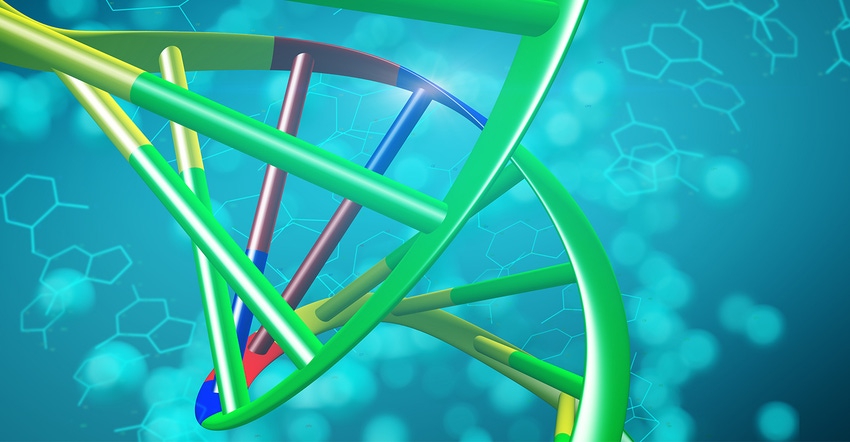
Larry Gilbertson may be a little bit wistful at this point in his career. A long-time gene scientist working with crops, Gilbertson's excited about the next level of genetic work and kind of wishes he wasn’t this far along in his career.
"Gene editing is very exciting," he says. "I’ve been doing this for 23 years, and I wish I had another 23 years to go. This is the most exciting technology."
Gilbertson is the applied genomic modification lead at Bayer, and in his career at what was formerly Monsanto he’s followed the development of genetic engineering technology from those early days. Along comes gene editing and CRISPR-Cas9 tech, and Gilbertson sees the potential. And he’s at work sharing the good news of what this technology means for food crops. He recently spoke at Foodscape, a food-focused event, where he spoke about the future of food and the role of gene editing.
"It was a great meeting and a great experience," Gilbertson says. "I was there to talk about gene editing and how it can be used. I was there to discuss the role of genetic engineering in the future of food."
He explains he’s a scientist first and discusses how the work of genetic engineering can be used for the future. His discussion talks about the fact that there’s already a lot of variation in food, and that genetic editing works to precisely manage variation to obtain a desired result. The result might include disease resistance, or an output trait like a sweeter tomato, but with these new tools the work can be very precise.
In talking with Farm Progress, however, Gilbertson admitted that the average consumer may not be aware of the genetic variation in the foods they eat. "I do wish people did know that broccoli, cauliflower, kohlrabi, Brussels sprouts and kale all come from a similar background and their differences were bred over time," he said. "No one would confuse broccoli with kale, but they came about by humans selecting for variation."
He adds that the kind of work molecular biologists are doing with genetic editing is essentially the same work that humans have been taking advantage of for thousands of years. Gene editing is just more precise than selection or cross-breeding over time.
Precision and the future
Gilbertson is an advocate for the tech, and he understands there’s work to do for consumers. Recently, the European Court of Justice ruled that crops that result from gene editing should be regulated just as if they were transgenic, or GMOs. He expressed his quiet frustration with the European approach to the technology, noting that in Europe regulation is "based on the process rather than on the product," which is opposite other regulators around the world.
"The decision does not make sense in the light of science," he says. "The product is like any other product that results from traditional breeding."
 GENE EDITOR: Larry Gilbertson has a long history working with crop tech and genetic engineering. He sees plenty of potential with gene editing technology for the future of food production.
GENE EDITOR: Larry Gilbertson has a long history working with crop tech and genetic engineering. He sees plenty of potential with gene editing technology for the future of food production.

As someone excited about the future of gene editing, Gilbertson also explains that the science is still progressing. Yet there are potentially new ways of doing traditional crop tech. For example, would hybrid breeding tech go away if it was possible to move traits into a final plant without that in-field process? Gilbertson admits that might be possible.
"With gene editing, I think if I want this variant or these variants into a plant, rather than using two plants to breed together and bring along the millions of other variants, I could go in and create those variants similar to how we get to hybrid corn," he says.
Essentially, it might be possible to "build" a plant with the right traits, yet there’s one factor that must be considered: "But the advantage of hybrid corn is heterosis, and we don’t understand the biology of heterosis. When it is understood, then breeders could breed in a way that might create heterosis without the need for a hybrid. The hardest part is figuring out the heterosis."
Heterosis is what gives hybrids that "vigor" or "yield bump" from the two parent in-breds. Gilbertson notes that someday it will be figured out; but it’s not understood yet. "I have a colleague that compares this new tool to an engine. It’s very complicated and we don’t understand how all the parts of the engine work; we don’t understand how all of the genes work, yet," he says.
For the parts of the genome they do understand, though, Gilbertson sees great promise. "We have a long history of breeding and we have a huge range of germplasm," he says. "And we’re bringing the power of data to the process."
That database of germplasm, traits and how genes work in the plant offers a range of opportunities. But Gilbertson says gene editing is also an equalizer. "GMO regulations and technology take a lot of investment," he says. "With gene editing, the tools for making plants better are more accessible to more companies. This has democratized genetic engineering and that can’t be a bad thing."
About the Author(s)
You May Also Like




